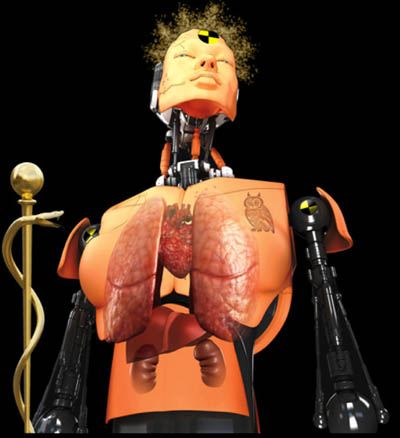What Makes Us Human? Scientists Come One Step Closer To ‘Creating’ A Human Being
Source: activistpost.com
Being very interested in all things scientific I am always amazed by the massive leaps and bound in science and technology that seem to be gathering pace as time moves on. Having said that, every so often I see something, that upon closer scrutiny makes me wonder where it’s all going and what the outcome will be for us mere mortals. This article is about one such development. Scientists have for decades wanted to find a way where they can actually ‘see’ the damage done to our internal organs by toxins that range from drugs to air pollution. Evidence from autopsy and cadaver studies show the links between toxins and human health but often, such study does not show why it happens, it doesn’t show the mechanisms that causes the reactions.
Scientists have for decades wanted to find a way where they can actually ‘see’ the damage done to our internal organs by toxins that range from drugs to air pollution. Evidence from autopsy and cadaver studies show the links between toxins and human health but often, such study does not show why it happens, it doesn’t show the mechanisms that causes the reactions.From Science Daily:
Significant progress toward creating “homo minutus” — a benchtop human — was reported at the Society of Toxicology meeting on Mar. 26 in Phoenix.
The advance — successful development and analysis of a liver human organ construct that responds to exposure to a toxic chemical much like a real liver — was described in a presentation by John Wikswo, the Gordon A. Cain University Professor and Director of the Vanderbilt Institute for Integrative Biosystems Research and Education (VIIBRE) at Vanderbilt University.
The achievement is the first result from a five-year, $19 million multi institutional effort led by Rashi Iyer, senior scientist at Los Alamos National Laboratory (LANL), and Wikswo. The project is developing four interconnected human organ constructs — liver, heart, lung and kidney — that are based on a highly miniaturized platform nicknamed ATHENA (Advanced Tissue-engineered Human Ectypal Network Analyzer). The project is supported by the Defense Threat Reduction Agency. Similar programs to create smaller, so-called organs-on-chips are underway at the Defense Advanced Research Projects Agency and the National Institutes of Health. You can read the rest of the article here.
Now I realize that these are at this point only constructs, but, and there’s always a but, how far will such technology go?
We are already seeing the growing of human tissue in the lab, the manipulation of stem cells which can be cultured into any tissue in the human body. How long will it be before someone combines the two technologies?
Now this would not be all bad, growing full replacement organs for those who need transplants would alleviate the suffering of million, but, once organs can be grown routinely, and that technology is combined with the constructs that shows the minute detail of what makes them work, we are well on the way to ‘creating’ a human being.
The question is, what makes us human?
[...]
Read the full article at: activistpost.com

ScienceDaily: "The ATHENA organ project combines heart, liver, kidney and lung features in a desktop toxicity testing platform."
Red Ice Editor Note:
Part human, part machine, with strange ’hair’ like a crown. ATHENA.
Note the powerful symbols of snake, owl, and the Rod of Asclepius (sometimes confused with the Caduceus):
From Wikipedia:
Athena’s Owl
In Greek mythology, a Little Owl (Athene noctua) traditionally represents or accompanies Athena, the virgin goddess of wisdom, or Minerva, her syncretic incarnation in Roman mythology.Because of such association, the bird — often referred to as the "owl of Athena" or the "owl of Minerva" — has been used as a symbol of knowledge, wisdom, perspicacity and erudition throughout the Western world.
Source
The Caduceus:
The caduceus is the traditional symbol of Hermes and features two snakes winding around an often winged staff. It is often mistakenly used as a symbol of medicine instead of the Rod of Asclepius, especially in the United States. The two-snake caduceus design has ancient and consistent associations with trade, eloquence, trickery, and negotiation. Tangential association of the caduceus with medicine has occurred through the ages, where it was sometimes associated with alchemy and wisdom.
The modern use of the caduceus as a symbol of medicine became established in the United States in the late 19th and early 20th century as a result of documented mistakes, misunderstandings and confusion.
Source
The Rod of Asclepius:
The Rod of Asclepius takes its name from the god Asclepius, a deity associated with healing and medicinal arts in Greek mythology. Asclepius’s attributes, the snake and the staff, sometimes depicted separately in antiquity, are combined in this symbol.
The most famous temple of Asclepius was at Epidaurus in north-eastern Peloponnese. Another famous healing temple (or asclepieion) was located on the island of Kos, where Hippocrates, the legendary "father of medicine", may have begun his career. Other asclepieia were situated in Trikala, Gortys (in Arcadia), and Pergamum in Asia.
In honor of Asclepius, a particular type of non-venomous snake was often used in healing rituals, and these snakes – the Aesculapian Snakes – crawled around freely on the floor in dormitories where the sick and injured slept. These snakes were introduced at the founding of each new temple of Asclepius throughout the classical world. From about 300 BC onwards, the cult of Asclepius grew very popular and pilgrims flocked to his healing temples (Asclepieia) to be cured of their ills. Ritual purification would be followed by offerings or sacrifices to the god (according to means), and the supplicant would then spend the night in the holiest part of the sanctuary – the abaton (or adyton). Any dreams or visions would be reported to a priest who would prescribe the appropriate therapy by a process of interpretation. Some healing temples also used sacred dogs to lick the wounds of sick petitioners.
The original Hippocratic Oath began with the invocation "I swear by Apollo the Physician and by Asclepius and by Hygieia and Panacea and by all the gods ..."
The serpent and the staff appear to have been separate symbols that were combined at some point in the development of the Asclepian cult. The significance of the serpent has been interpreted in many ways; sometimes the shedding of skin and renewal is emphasized as symbolizing rejuvenation, while other assessments center on the serpent as a symbol that unites and expresses the dual nature of the work of the physician, who deals with life and death, sickness and health. The ambiguity of the serpent as a symbol, and the contradictions it is thought to represent, reflect the ambiguity of the use of drugs, which can help or harm, as reflected in the meaning of the term pharmakon, which meant "drug", "medicine" and "poison" in ancient Greek. Products deriving from the bodies of snakes were known to have medicinal properties in ancient times, and in ancient Greece, at least some were aware that snake venom that might be fatal if it entered the bloodstream could often be imbibed. Snake venom appears to have been ’prescribed’ in some cases as a form of therapy.
Source






















